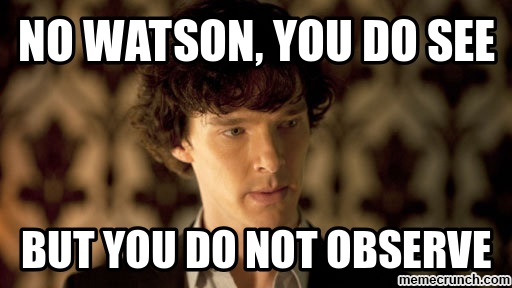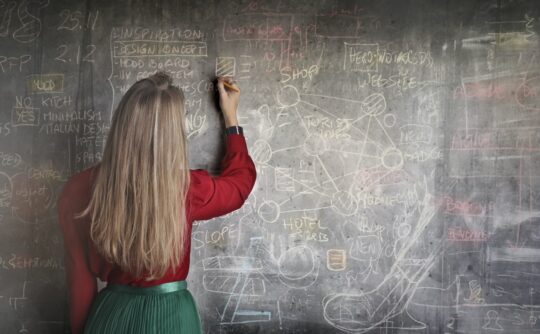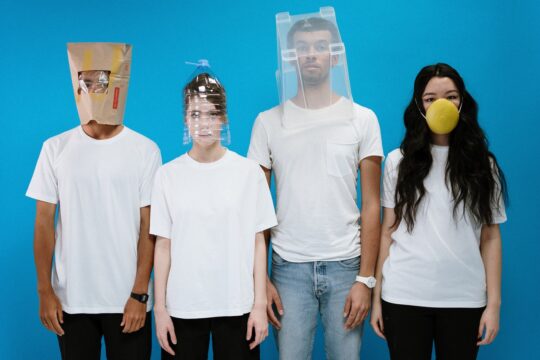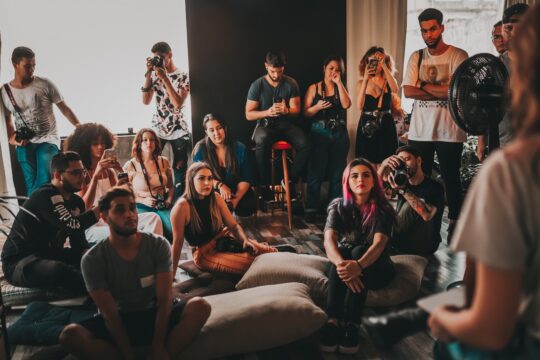In this concise guide to critical thinking we will explore in depth Critical Thinking Skills and various ways in which it can serve us in different aspects of our life. Without a doubt Critical thinking can be used in all aspects of our modern life, but now it is even more important to familiarize ourselves with critical thinking strategies in order to be able to choose a path that benefits us the most, in business, education, life and all the way to a worldwide pandemic.
Critical Thinking : Introduction
Critical thinking is a step-by-step, careful, goal-directed thought process by which we find the positive and negative features of any argument, ours or someone else’s, explain the reason for one or another decision, and be more sure as a result that we have the right answer at the conclusion of the process.
With critical thinking, you will be able to understand the logical connections between ideas, find errors in reasoning, and evaluate beliefs and values. This is simply not a question of having your facts straight, not a matter of accumulating information. In our everyday life, we analyze information and resolve problems through higher level thinking skills (Facione, 1990).
In order to live a meaningful life, we need to base our values and decisions on proper tools for this process. It is “the mental processes, strategies, and representations people use to solve problems, make decisions, and learn new concepts”. What this means is that a disciplined and reflective mindset is very important to the development of this kind of meta-cognitive thinking.
Critical solutions require not just great ideas, but also ones that are purposeful and relevant to the task at hand involving such procedures as evaluating new ideas, selecting the best ones and modifying them if necessary. Put simply, critical thinking includes “the mental processes, strategies, and representations people use to solve problems, make decisions, and learn new concepts” (Sternberg, 1986).
Observation in critical thinking:
Observing: To be a critical thinker, we need to be attentive to our surroundings, noticing what is unexpected or incongruous. For example a police officer on patrol is trained to notice what may be suspicious, and simply does not belong to what is normally there, draw conclusions from that, sometimes by inference rather than direct observation, so that one can then consider whether the inference is justified.

As an example most of us are familiar with, a Sherlock Holmes story “Silver Blaze” involves the disappearance of a famous racehorse the night before a race and the murder of the horse’s trainer. Sherlock Holmes solved the mystery through inference. He asked himself what was missing from the account of observations, rather than exclusively what was present. He recognized that no one mentioned the barking of a watchdog. If the dog did not bark, then the dog must have known the one who carried out the crime.
Gregory (Scotland Yard detective): “Is there any other point to which you would wish to draw my attention?”
Sherlock Holmes: “To the curious incident of the dog in the night-time.”
Gregory: “The dog did nothing in the night-time.”
Sherlock Holmes: “That was the curious incident.”
Mental Tools for Critical Thinking
Experiment: The great educator and philosopher Thomas Dewey devoted a whole chapter of his How We Think (1910) book to explaining why experimentation is superior to observation in advancing knowledge on a sure foundation. The scientific method involves formulating the problem precisely, setting out a method of objective testing independent of our own desires, gathering solid data, and basing our conclusions entirely on that evidence.
Self-reflection: We need insight into our own minds, what we really think and believe separate us from what we would like to have in our thoughts. We all have our concealed shadow side, our strengths and weaknesses that must be set aside with a willingness to see through, and therefore gain control over the aspects of ourselves which we need to work on, despite how that recognition disturbs our pride. In fact, a strong desire for self-improvement is the basis of successful self-improvement.
Consulting: You can only see the problem from one perspective… your own, as a thinking subject with memory, emotion, psychological disposition and life experiences. Consulting has become easy. Forget your friends and associates. They are all thinking subjects looking at matters from their own particular angle, but you have access to the expertise of the Internet, including chat-groups gathered around one or another issue ,whether involving health, politics, career, virtually any issue under consideration.
But you need to be critical extracting information from sources and evaluating their credibility as a preliminary to evaluating its strength. It is an important part of a critical thinking process to survey arguments from various positions on any issue, though be careful of credibility.
Feeling, Wondering, Imagining: Consult your feeling and first impression, and pass it through your critical reflection to evaluate what your heart is telling your mind. The emotions that drive a critical thinking process are the feeling of confusion, perplexity or puzzlement, and a wish to resolve it.
Keep alive your sense of wonder to trace unexpected turns that reality takes contrary to precedent and our expectations. We need to be skeptical about even things we are sure about and engage in reflective skepticism” (McPeck, 1981) Always, use your creative imagination to think of alternatives, or strategies that increase the probability of a desirable outcome.
Argument analysis: We all need to employ logical systematic thought to analyze arguments on any issue in order to form reasoned judgment and achieve good results, a willingness to examine issues with an open mind.
The ability to draw conclusions from given information, and to recognize with what degree of certainty one’s own or others’ conclusions follow logically gives our thought and convictions a degree of certainty that we and others could depend on.
Being well-informed, considering seriously points of view other than one’s own, looking for logical alternatives, suspending judgment when the objective evidence is insufficient, and basing your position on a coherent argument is the key to critical thinking success.

Critical Thinking: In Education
Today one of the most important criteria for success in any form of higher education is the ability to think independently while being logical at the same time. With the amount of information increasing daily and new information quickly replacing what we formerly believed, thinking critically has become an essential skill for students at every level, most especially in college, university studies and most recently in online education.
Multiple surveys indicate that employers believe that recent grads do not have the critical-thinking skills those employers expect, which puts an enormous demand for educational institutions to develop the ability to evaluate the connection leading from theory to evidence and potential conclusions.
To make logically sound judgments, identify assumptions and alternatives, ask relevant questions, and to be fair and open-minded when evaluating the strength of arguments (McPeck, 1984).
A recent article in the Wall Street Journal reported, “On average, students make strides in their ability to reason, but because so many start at such critical thinking deficit, many still graduate without the ability to read a plot, construct a cohesive argument or identify a logical fallacy.
Critical thinking skills help students reason through content, gain overall knowledge and retention of important facts and processes from the material studied. All assignments students will be assigned require systematic thought processes, problem-solving, deductions, and inferences based on previously presented or known information.
It is needed to explain what something means in its original context, gather and analyze relevant information, identify false and distorted information, approach difficult problems in an orderly manner separating pros and cons—all of which are based on the synthesis of data or other sources.
But what does it mean to think critically ? That depends.
Overcoming fallacies and biases: Arguments are found pretty much everywhere, in commercials, political speeches, textbooks, and anywhere else where reasons are presented in an attempt to get the reader or listener to believe that the conclusion is true by verbal tricks rather than solid evidence. Develop a critical thinking approach to the things you see and hear in the media.
Theory: What is the theory explaining? What is it arguing for and against? What was it saying originally in its historical context? How could it be applied? A theory is just like a thesis statement in an essay, but more fully developed. To come up with a creative solution to a problem involves not just having new ideas, but explain how it is relevant in a precise way on solid foundations. There is a problem that you resolve by a method that applies to all problems like that in any field, nursing, business, engineering or any other area of studies.
Argument analysis: What is the conclusion, the evidence, and reasoning used to support the conclusion, assumptions, the evidence against it, and when the conclusion may not apply. Emotion is the enemy of reason. It’s easy to let your emotions take over when making an important decision or arguing for your opinion, especially if you are personally invested in it. By tracing the logic of arguments entirely on its logical structure, and not whether it satisfies an emotional need allows for more accurate judgment regarding the kind of issues that require objectivity found in higher level thinking.
How could one use Critical thinking skills in a an educational setting?
Summarize the writer’s ideas after each chapter. It will help you to memorize all the key points.
Evaluate the most important ideas of the information processed by considering the pros and the cons and explain why you believe they are important and relevant, or why you need to question, challenge, or reject them.
Examine the strategies the writer uses to structure his/her content and organize the ideas to develop your own perspective, and propose new ways of thinking about the subject at hand.
Describe the meaning of what had been describes by classifying, comparing, comprehending, distinguishing , estimating, explaining, generalizing, outlining, and summarizing.
Apply the use of previously learned information in new and concrete situations to solve problems by classifying, completing, demonstrating, and solving the problem that was asked
Analyze by breaking down of informational materials. Can you make your own conclusions based on this material?
Synthesize by putting it all together and coming to a conclusion. This will help you to retain this information in the long-term memory for many years.

Critical Thinking: For Business
Business people make countless decisions. Some are good decisions with demonstrable and quantifiable results, they are usually bringing profits. Others are poor decisions that hurt the business and reduce profit. A business analyst’s job is to evaluate data and make informed decisions regarding a company’s performance.
Careful critical thinking can uncover innovative solutions to address issues that come up and to boost business growth. But you must form arguments from evidence, while naming problems and assumptions that can get in the way of evaluating an issue for what it is. It’s about solving problems in a systematic way by objective evidence – and in the business world, these skills save time and money and get practical results that are carefully quantified, a lot depending on well thought-out decisions that come from critical thinking skills.
You will use critical thinking to design solutions to meet your customers’ needs. In the medical field, you need critical thinking skills when evaluating the rapidly changing condition of the patient, assess the information on a chart and make the right decisions for the patient’s well being. In management, you need to put aside emotions to make the best choices for your team.
Noticing and questioning assumptions helps to reveal information gaps or unfounded logic. We also need to examine assumptions objectively and accurately, questioning the quality of supporting evidence, and understanding how emotion influences the situation. Bringing diverse information together to arrive at conclusions that logically follow from the available evidence is crucial when making a decision that results in good judgment and a clean rational approach.
These are the questions you will have to work through.:
- What is the key issue/problem that you are trying to solve?
- What information and facts do you have about this issue?
- What are your ideas and assumptions to your theory?
- Is there evidence?
- What are the viewpoints of your team-members?
- What are the pros and cons of the solution you are proposing?
- What impact will your decision have on others?
- What will be the financial impact of your decision?
- What opportunities does your solution provide and what are the risks?
In business you are part of a team. Thinking, working with and affecting others in the decision-making process, asking questions and listening to the responses with an open-mindedness and flexible attitude will develop the business and open new doors to growth.
Critical Thinking: In Life
How many situations have you faced in your life where you needed critical thinking to avert bad choices and even disaster whether in buying a house, making travel plans or entering romantic relationships. You had not considered all your options, nor set aside emotions in order to have an accurate assessment of the consequences of a particular action.
In most life situations, critical thinking means not rushing major decisions. It also means considering all possibilities with realistic assessments of how they might play out.
We are bombarded with information daily, which is both a gift and a curse. We can’t make decisions without solid evidence, sifting through too much information to ensure that we can’t see the wood because of the trees. The only way to assess information is by applying critical thinking skills in the most ordinary areas of our life in which we parent, form relationships and resolve all manner of personal issues.
When we think critically, we go beyond impulsive gut reactions driven by our feelings to analyze the approaches that are available and choose the ones most likely to work because we are capable of a certain degree of prediction of future outcomes based on current situations.
Thus we are more likely to accept good opportunities that others might pass by, and we are less likely to act rashly in accepting bad opportunities for the wrong reasons.
In fact, critical thinking is about using methods of perception and reasoning that will lead you to see any life situation more clearly and therefore inwardly have a more accurate representation of situations. If you act on emotions, egotism and false beliefs that you had not thought through, you are likely to choose a wrong course of action. That is why using critical thinking can lead to making positive choices.
To use critical thinking, we must almost pull ourselves physically back from that impulsive decision. We need to make not just a conscious choice but a deliberate one in which we decide to take specific steps towards those positive choices.
Make sure to go through the process carefully. Decide what you are aiming to achieve and then make a decision based on available alternatives. You keep on track until changing circumstances mean you have to revisit the start of the decision making process.
Consider these critical points next time you have to make a decision in your personal life:
- What are you trying to achieve? Your desires can over-rule your rational decision making abilities, so first and foremost, you should evaluate “why” you feel that you must make the choice, and whether it may be better to delay final decisions until more valid information becomes available. Wherever possible take problems one by one. State the problem as clearly and precisely as you can. In other words, systematically think through the issue with goals, purposes, and needs in your mind.
- Define the problem carefully. How a situation is defined determines not only how we feel about it, but also how we act in it, and what implications it has for us. However, virtually every situation can be defined in more than one way. You may think the problem lies in one direction only to find matters coming from another direction,
- Reduce your choices to realistic alternatives. Using critical thinking, you can discard approaches that won’t work “right away”, that is, efficiently skipping many surely wrong paths. Study the problem to make clear the “kind” of problem you are dealing with. Figure out, for example, what sorts of things you are going to have to do to solve Carefully analyze and interpret the information you collect, drawing what reasonable inferences you can until all possible alternatives had been considered.
- Decide if the decision is yours to make. Distinguish problems over which you have some control from problems over which you have no control. Set aside the problems over which you have no control, concentrating your efforts on those problems you can potentially solve. You may need expert advice, and your choice may narrow to seeking the right person to handle your problems.
- Adopt a strategic approach to the problem and follow through on that strategy. This may involve direct action or a carefully thought-through wait-and-see strategy. When you act, monitor the implications of your action as they begin to emerge. Be ready at a moment’s notice to revise your strategy if the situation requires it. Be prepared to shift your strategy or your analysis or statement of the problem, or all three, as more information about the problem becomes available to you.

Critical Thinking: In a Pandemic
With the mass shutdowns across the country and throughout the world, this are the times we need to deal with uncertainties in a cool and rational manner, and not only for ourselves ,but also those near to us, and may need good counsel based on careful and methodical thinking for the uncertainties we face.
News of global pandemic breaks out. You hear everyone is rushing to buy toilet paper. Conspiracy and extreme thinking abound. Use the tools of critical thinking to find out the best way to process information and arrive at conclusions.
Fake news, Twitter bots, online chatter. How to tell truth? Critical thinking is the rational assessment of a claim in order to determine whether you should accept a claim as true, reject it as false or suspend judgment about the claim.
• Who published this?
• Why did they make it?
• What are their sources?
• What are their intentions?
• Are they representing themselves or another interest?
Don’t make emotional decisions without solid evidence, sift through information, employ thinking tools, observe, assess, and adjust your thinking methodically to problems as they arise, in a complex, rapidly changing situations where risk is high and information is limited.
Deploy the instruments of thought to identify conflicting information, assess their credibility and accuracy to determine through varied thinking tools what actions ought to be taken in response.
“When critical thinking is literally a matter of life or death, we can no longer afford to keep treating it like a luxury good,”. The true costs of the pandemic will be all the greater if we act thoughtlessly in an undisciplined manner.
It is unclear what kind of world we will create when it is all behind us, however by applying critical thinking we will have a clearer grasp on what is happening around us and we’ll be able to determine a set of actions that benefit us the most.
If you want to learn and improve yourself check our Online Course Library




